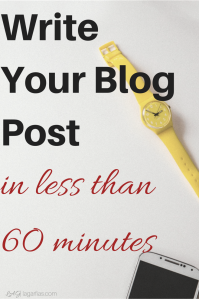
I’ve been blogging for about a decade now. For the last five years, I’ve written for various print and online publishers. Most recently, I’ve been working as a copywriter for a marketing firm, where I write blog posts for various industries, including medical, nutritional, sports, decorating, and digital marketing companies.
You could say I’ve written a lot of articles.
While doing this, I’ve noticed that I have developed two different kinds of writing. One gets the job done and pays the bills. The other is more meaningful, artistic, and self-fulfilling (and published primarily on my own blog, ironically). Today, I’m talking about the former.
 There is a simple formula for writing the majority of online content. Like our media consumption, it is fast, direct, and to the point. Obviously, since I make my living off that industry, I don’t believe that is all bad. A quick explanation is just the ticket for most internet consumption; we use this formula because it works.
There is a simple formula for writing the majority of online content. Like our media consumption, it is fast, direct, and to the point. Obviously, since I make my living off that industry, I don’t believe that is all bad. A quick explanation is just the ticket for most internet consumption; we use this formula because it works.
But as writers, we obviously cannot let this be our only expression. I feel that it is important, if you engage in this quick type of writing on a regular basis, that you also develop a disciple of artistic writing. If you don’t use complex-compound sentences, you’ll lose them, and you may never find them again.
If any of my English students find this blog post, then they had better understand that this is also not how to write a paper, essay, or anything at all a teacher will ever read. Your instructors in any subject can tell if this is what you did, and you will be disappointed in the results. Put more time into your research and development, and you’ll end up with a better paper and better grades.
So now with all my excuses out of the way, here is the recipe for a quick-and-easy blog post. With practice, you’ll get faster and faster, definitely less than an hour. I am down to 20-30 min per 500 words, depending on the topic, but always less than an hour.
This entire strategy works best with a visible stop watch. I’m dead serious about that. I use Ultra Stopwatch and Timer Windows 8 app, but I’ve also used a timer on my phone and an egg timer. The important part is that you can see out of the corner of your eye the time ticking down. It makes the entire process work faster, I promise.
Do these steps in this order. The secret is in the order of operations.
1. Pick a topic and title.
Your topic and title will likely go together, but you can not move forward until you have the title. Yes, I know this goes against every good writing rule, but most blog posts are not art, they’re science.
Collect lists of blog post titles for this very reason. I have a large section in Microsoft OneNote just for this purpose. It contains lists and lists of blog post titles and topic ideas. It should take 2 minutes or less to chose an appropriate one for the task at hand.
Write the title at the top in large letters as though it were etched in your soul. This is all you will think about for the duration of the project.
So for you English purists, think of the title as the thesis statement in fragment. A blog post revolves around the title. Why? Because Google said so, and we obey.
2. Brainstorm an outline.
Hopefully, you are writing about something you know a little about. But if it’s a writing assignment, probably not. Spend less than 10 minutes brainstorming the basic outline of the piece.
I literally write INTRO at the top of the page, scroll down a couple lines, and start listing points. They don’t need to be in order, just get something on paper — fragments of ideas, lists of reasons, statistics, anything you need.
The more you practice this formula, the better feel you’ll have for how much info is just right for your word count. I have an idea for my own style of writing, so I try for at least 5 points for a 500-word piece. That’s easy for me to write fast. If I have fewer points, I find myself filling in too many gaps with extra words and sweating over the extra 100 words I need. Conversely, if I have 8 or more points, the piece writes itself in record time.
3. Write the thing.
Take a deep breath, look at how much time has already flown by, and start pounding the keys. Really hard. Start with the introduction and use 100 words or so to explain why someone should care enough to read this article in the first place. Then introduce the structure of your blog post (is it a checklist? Reasons your thesis is true? Contrasting ideas?) in one or two sentences. Now you are ready to plunge into your main points.
One by one, attack the points and write until each is explained and/or your word count is reached. Adjust word count as necessary. Add a conclusion if there is space. If it’s a marketing piece, make your last sentence an imperative, demanding the reader take action with a contact, sign up, or purchase.
DONE!
Rub your hands together and glance at the clock. Ten minutes or more left? You are nearly finished!
4. Reread the entire piece.
From beginning to end, read the article through. Read it out loud if possible. Fix any mistakes and clean up the flow so it works like one, solid piece.
You will notice I’m light on the editing. I don’t feel like web writing is worth over-editing, even though my livelihood depends on quality. I’ve learned over the years three things about editing:
1) It would take me days or weeks to edit really well.
2) I am poor at self-editing.
3) Anything on the internet can be changed after publication if it’s that important.
I’ve become much more comfortable with my own fallibility, too. My grammatical errors will bother you much more than they do me. 😛 Finally, it’s really, really nice to know that magazines and online editors catch the really stupid things I do, so I look better elsewhere then I do here.
This is why you should always be very nice to your editor.
5. Add links.
Most blog posts should have three or four links to other content (blog posts) or products to purchase. I don’t know who made that rule, but there it is. If you are writing for your own blog, it should be relatively easy – just add links to content that relates to a couple main points.
If you are writing for another website you are less familiar with, you can still do this quickly. Use their search. If they have a crummy or non-existent search, start with the blog archives. Pick a random page of blog archives, then start looking at titles as you scroll down. You only need to find 4 titles that loosely relate to anything you said in the post. Don’t forget a link on the call to action at the end, too.
6. Find the image.
If you are working for a company, this is quick, too. Just grab a good-quality image from their stock photo source, and you’re good to go.
If you are writing for yourself and cutting costs, this takes a couple extra minutes. Start collecting lists of free stock photo sources. Become familiar with the attribution requirements of your top three favorites. Then search for your photo. It will take you a little more time on a free site to find a good pic, but with experience you’ll get faster. Don’t spend too long browsing on any one source; if they don’t have a good one on the first page or two of results, it ain’t there. Try somewhere else.
And that’s it!
There’s my quick and easy formula for writing blog posts. Does it work? Well, the blog posts sell, so it’s working for me. Writing quickly also exercises your writing skills, strengthening your discipline and helping you overcome resistance.
And this post, by the way, is over 1300 words long and took me less than 45 minutes total to write and 30 minutes to edit. Not so shabby.



Good tips. I especially like the list of topics. I have a lot of them in my notepad.
That’s great!
I need this advice. Thanks! I had an occasional blog on another aggregating site that I updated once or twice a month, and I could keep up with that, but then I started my own blog here on Word Press. I’ve been at it for about a month, and I’m finding that on days I blog I’m too tired to write anything else that day!
I know it is tough! Setting a regular writing time every day helps me, along with goals and word counts. But it is a struggle to maintain the discipline of regular writing.
Very helpful post Lea Ann! I’m hoping to get back into writing more after an extended break….very hard. This encouraged me!
I’m so happy to hear that — both that this was helpful, AND that you’re writing again!
Excellent tips to more effective blog writing, Lea Ann! Thanks for sharing!
I’m so glad to help! 🙂